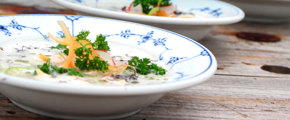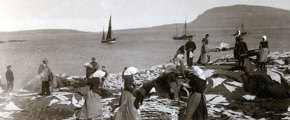Langoustine
The Faroese langoustine lobster is some of the best shellfish imaginable - an exclusive and luxury produce that is served in some of the world’s foremost restaurants.
The langoustine can be found in Faroese fjords that have some of the cleanest and freshest marine environments in the world. The temperature of the waters around the Faroe Islands is consistently around 8 degrees Celsius all year round. These factors can be tasted in the delicious flavour of Faroese langoustines, as they are able to grow and mature slowly and steadily.
The Faroese langoustine is renowned for its rich and delicate texture and taste. It is in high demand all over the world. The langoustine’s white meat has an enticingly deep flavour with a perfect balanced salty and sweet taste. The texture is crisp and firm, with a consistency you will not find in other lobsters.
The langoustine can be grilled or cooked and works well in casseroles and pasta dishes. It is also excellent in combination with other shellfish, such as shrimp or scallops.
The Faroese export langoustines live in order to ensure that they provide their buyers with the freshest produce possible. Langoustines from the Faroe Islands are served in gourmet restaurants across the world. These include NOMA in Copenhagen, which has been named the world's best restaurant on multiple occasions.
Langoustine is healthy food and especially rich in protein, vitamin B12, selenium and iodine.
Biology
Langoustine (Nephrops norvegicus) has many names, Norway lobster, Dublin Bay prawn or scampi.
In the Faroe Islands langoustine is called Hummari or Jomfrúhummari.
The langoustine is orange in colour and has a similar shape to a lobster but is smaller and narrower in size. It has five pairs of legs that grow gradually smaller towards the back. The front pair have long, slim claws. The langoustine has 4 antennae – one short and stubby pair and one long and slim.
The langoustine is usually about 18-20 cm in length when caught but can grow up to 25 cm long. This includes the tail and clawed legs. They can live up to 15 years.
Langoustine are most commonly found at depths of about 20-800 metres. They prefer an ocean floor with sand, mud and/or soft clay.
The langoustine has small kidney-shaped eyes that are extremely sensitive to light. They will burrow into the soft seabed to hide and shield themselves from light. They will usually only venture out of their burrow during the night. This is less of an issue where it is too deep for the sunlight to reach. The langoustine is an omnivore that mostly feeds at night, with prey such as crustaceans, worms and molluscs, to name a few.
Langoustine spawn during the summer. The female will carry about 1000-5000 fertilised eggs for 8-9 months before they hatch. The larvae will float in the ocean for up to 60 days before settling on the bottom. Once they have settled they are very territorial and will not travel far.
The langoustine can be found all over the Northeast Atlantic, from northern Norway, around the Faroe Islands and Iceland and south to Portugal.
The Faroese langoustine is caught in fish-traps in Faroese fjords.




